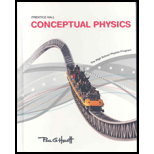
Concept explainers
To Explain: Whether a person gets younger by travelling at speed near the
Explanation of Solution
Introduction:
Twin paradox is the famous example in special theory of relativity. According Einstein’s Special Theory of Relativity, the time observed by the different observer depends on observer’s velocity. Time is not absolute according to
Where,
T = Time measured when person is in motion seen by the observer.
v = Velocity of the person with respect to ground observer.
c = Speed of the light.
Two synchronized clocks put together, one clock is sent with person to travel through space with speed comparable to the speed of the light and another clock is placed on the earth which is stationary. When the person returns from the space journey and time is measured in both the clocks, time measured by the person in spaceship and that of the stationary observer on the earth is different. The time shown by the clock travelled in the space is small as compared to the time shown by the clock which is stationary on the earth. By the same analogy, if a person measures his age before and after the space journey, he finds his age is less as compared to the age measured by the stationary observer on the earth.
Conclusion:
Therefore, relative to stationary person on the earth, person seems younger if he/she travels at the speed near the speed of light.
Chapter 15 Solutions
Conceptual Physics: The High School Physics Program
Additional Science Textbook Solutions
Campbell Essential Biology with Physiology (5th Edition)
Anatomy & Physiology (6th Edition)
Biology: Life on Earth with Physiology (11th Edition)
Human Physiology: An Integrated Approach (8th Edition)
Chemistry: A Molecular Approach (4th Edition)
Physics for Scientists and Engineers: A Strategic Approach, Vol. 1 (Chs 1-21) (4th Edition)
- From your examination of the graph created using the data in Data Table 4 of Period, T vs √L . What would you determine is the relationship between the period of a pendulum and the length of a pendulum?arrow_forwardIn a certain bimetallic strip, the brass strip is 0.100% longer than the steel strip at a temperature of 283°C. At what temperature do the two strips have the same length? Coefficients of linear expansion for steel α = 12.0 × 10−6 K−1 and for brass α = 19.0 × 10−6 K−1 (see Table 13.2).arrow_forwardReview Conceptual Example 2 before attempting this problem. Two slits are 0.158 mm apart. A mixture of red light (wavelength = 693 nm) and yellow-green light (wavelength = 567 nm) falls on the slits. A flat observation screen is located 2.42 m away. What is the distance on the screen between the third-order red fringe and the third-order yellow-green fringe? m = 3 m = 3 m = 0 m = 3 m = 3 Fringes on observation screenarrow_forward
- A film of oil lies on wet pavement. The refractive index of the oil exceeds that of the water. The film has the minimum nonzero thickness such that it appears dark due to destructive interference when viewed in visible light with wavelength 643 nm in vacuum. Assuming that the visible spectrum extends from 380 to 750 nm, what is the longest visible wavelength (in vacuum) for which the film will appear bright due to constructive interference? Number Unitsarrow_forwardA piece of metal is placed on top of a 2.0 - kg wooden block (mass density = 562 kg/m³) piece. UseArchimedes' principle to calculate the mass (in kg) of copper if the top of the wood surface is exactly at thewater's surface?arrow_forwardA filmmaker wants to achieve an interesting visual effect by filming a scene through a converging lens with a focal length of 50.0 m. The lens is placed betwen the camera and a horse, which canters toward the camera at a constant speed of 7.9 m/s. The camera starts rolling when the horse is 36.0 m from the lens. Find the average speed of the image of the horse (a) during the first 2.0 s after the camera starts rolling and (b) during the following 2.0 s.arrow_forward
- What is the direction of the magnetic force on a NEGATIVE CHARGE that moves as shown in each of the six cases?arrow_forwardHi! I need help with these calculations for part i and part k for a physics Diffraction Lab. We used a slit width 0.4 mm to measure our pattern.arrow_forwardExamine the data and % error values in Data Table 3 where the angular displacement of the simple pendulum decreased but the mass of the pendulum bob and the length of the pendulum remained constant. Describe whether or not your data shows that the period of the pendulum depends on the angular displacement of the pendulum bob, to within a reasonable percent error.arrow_forward
 College PhysicsPhysicsISBN:9781305952300Author:Raymond A. Serway, Chris VuillePublisher:Cengage Learning
College PhysicsPhysicsISBN:9781305952300Author:Raymond A. Serway, Chris VuillePublisher:Cengage Learning University Physics (14th Edition)PhysicsISBN:9780133969290Author:Hugh D. Young, Roger A. FreedmanPublisher:PEARSON
University Physics (14th Edition)PhysicsISBN:9780133969290Author:Hugh D. Young, Roger A. FreedmanPublisher:PEARSON Introduction To Quantum MechanicsPhysicsISBN:9781107189638Author:Griffiths, David J., Schroeter, Darrell F.Publisher:Cambridge University Press
Introduction To Quantum MechanicsPhysicsISBN:9781107189638Author:Griffiths, David J., Schroeter, Darrell F.Publisher:Cambridge University Press Physics for Scientists and EngineersPhysicsISBN:9781337553278Author:Raymond A. Serway, John W. JewettPublisher:Cengage Learning
Physics for Scientists and EngineersPhysicsISBN:9781337553278Author:Raymond A. Serway, John W. JewettPublisher:Cengage Learning Lecture- Tutorials for Introductory AstronomyPhysicsISBN:9780321820464Author:Edward E. Prather, Tim P. Slater, Jeff P. Adams, Gina BrissendenPublisher:Addison-Wesley
Lecture- Tutorials for Introductory AstronomyPhysicsISBN:9780321820464Author:Edward E. Prather, Tim P. Slater, Jeff P. Adams, Gina BrissendenPublisher:Addison-Wesley College Physics: A Strategic Approach (4th Editio...PhysicsISBN:9780134609034Author:Randall D. Knight (Professor Emeritus), Brian Jones, Stuart FieldPublisher:PEARSON
College Physics: A Strategic Approach (4th Editio...PhysicsISBN:9780134609034Author:Randall D. Knight (Professor Emeritus), Brian Jones, Stuart FieldPublisher:PEARSON





